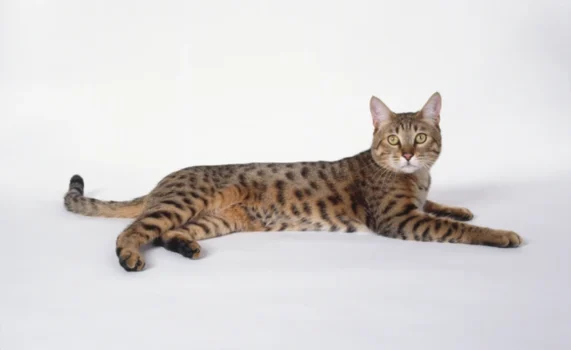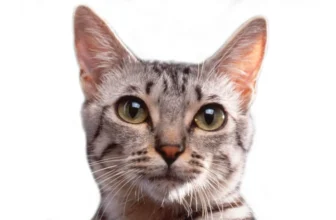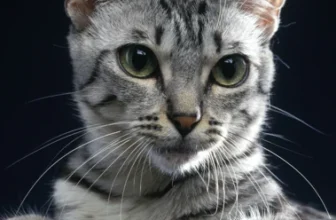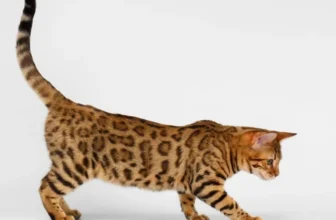Introduction
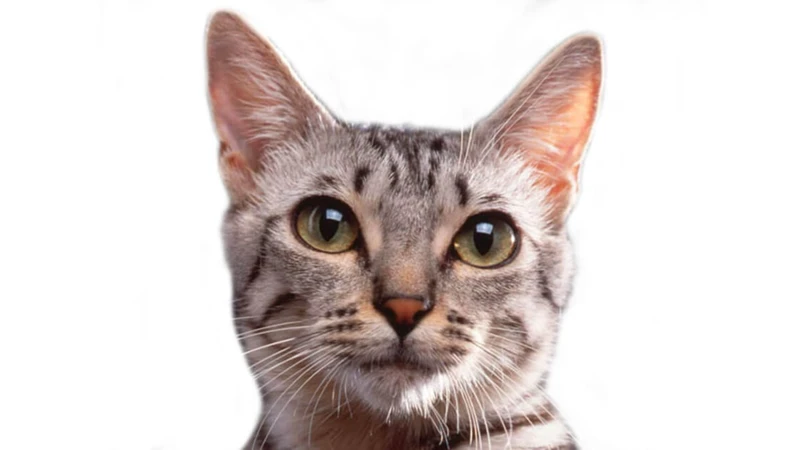
Welcoming you to this article, it is essential to understand the importance of being aware of genetic disorders in California Spangled cats. These beautiful felines are incredibly loving and playful, making them a popular choice among pet owners. However, genetic disorders may arise, and as responsible pet owners, we must take precautions to ensure our pets’ wellbeing. In this article, we aim to provide you with detailed information about the common genetic disorders that California Spangled cats may suffer from and how to avoid them. Along with that, we will also guide you on what to do if your cat has a genetic disorder. So, let’s dive in to learn more about the health of our beloved California Spangled cats.
What is the California Spangled cat?
The California Spangled cat is a breed of cat that was first bred in the 1980s by a conservationist named Paul Casey. Casey wanted to create a domestic cat that resembled the wild cats of the American Southwest. The result was a unique breed with a coat that mimics the spotted coat of a wild leopard or cheetah. These cats are known for their wild look and playful personalities.
The California Spangled cat is a medium to large sized cat. They have a muscular and athletic build, a short and sleek coat, and large, expressive eyes. They come in a variety of colors including silver, gold, bronze, and black.
These cats are known for their intelligence and their love for play. They can be trained to do tricks and are often compared to dogs in their loyal and friendly temperament. They are also known for being vocal cats and will often meow to communicate with their owners.
Fun fact: The California Spangled cat breed almost went extinct in the 1990s due to lack of interest, but has since made a comeback and is now recognized by some cat organizations.
Despite their unique and wild characteristics, California Spangled cats are still prone to genetic disorders like any other purebred cat. It is important to be aware of these disorders and take measures to avoid them when selecting a California Spangled cat.
To learn more about the genetics of the California Spangled cat, check out our article “Understanding California Spangled cat Genetics”.
Why is it important to be aware of genetic disorders?
Being aware of genetic disorders is crucial for any cat owner, especially those who are planning to acquire a California Spangled cat. These disorders can cause serious health problems for your feline friend, and, in some cases, may even be fatal. Here are some reasons why it is important to be aware of genetic disorders:
1. Early detection: Identifying genetic disorders early on can help you take steps to manage the condition and avoid long-term consequences. Regular checkups with a veterinarian can help you detect any developing medical conditions and get them treated promptly.
2. Preventive measures: Knowing which genetic disorders your cat may be predisposed to can affect the lifestyle measures you take, such as adjusting their diet, exercise regimen, and environmental factors to decrease the risk of potential health issues.
3. Breeding practices: If you are a breeder or planning to breed California Spangled cats in the future, you must be aware of the breeding risks associated with certain genetic disorders. For example, inbreeding can increase the risk of passing on genetic disorders to future generations.
4. Responsible ownership: Being an informed cat owner means taking proactive steps to ensure your cat’s wellbeing. By being aware of genetic disorders, you can be more attentive to any symptoms or changes in your cat’s behavior, and get them the proper care they need.
In short, being aware of genetic disorders can help you take better care of your California Spangled cat. To learn more about breeding practices and how to acquire a healthy California Spangled cat, check out our informative articles on /ca-spangled-cat-pedigree/, /california-spangled-cat-breeding-tips/, and /california-spangled-cat-inbreeding-impact/. If you want to mitigate the risk of genetic disorders in your cat, consider genetic testing. To learn more about this valuable option, read our article on /california-spangled-cat-genetic-testing/.
Common genetic disorders in California Spangled cats
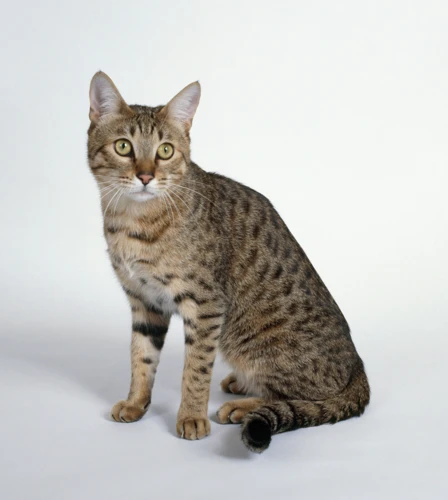
As with many other cat breeds, California Spangled cats are also susceptible to various genetic disorders. While not all cats will experience them, it’s important to be aware of the potential issues that can arise. In this section, we will take a deep dive into some of the most common genetic disorders that affect California Spangled cats and what you can do to prevent them from arising in your beloved pet. From hypertrophic cardiomyopathy (HCM) to muscular dystrophy, each disorder has its own set of symptoms and treatments that owners should be aware of. Understanding these disorders can help you take better care of your California Spangled cat, leading to a happier and healthier life together. And if you want to learn more about the breeding traits of California Spangled cats, make sure to check out our previous article here.
Hypertrophic cardiomyopathy (HCM)
Hypertrophic cardiomyopathy (HCM) is one of the most common heart diseases found in cats, including the California Spangled breed. HCM is a genetic disorder that causes the walls of the heart to thicken and become stiff, making it difficult for the heart to pump blood effectively. This can lead to symptoms such as shortness of breath, coughing, and lethargy, and in severe cases, can be fatal.
Factors that increase the risk of HCM in cats:
- Age – HCM is more common in middle-aged and older cats
- Gender – Male cats are more likely to develop HCM than females
- Genetics – California Spangled cats with a family history of HCM are at a higher risk of developing the disorder, as are purebred cats in general
Symptoms of HCM in California Spangled cats:
- Shortness of breath
- Coughing
- Lethargy
- Loss of appetite
- Weight loss
How HCM is diagnosed in California Spangled cats:
Diagnosing HCM typically involves a physical exam and imaging tests such as an electrocardiogram (ECG) or echocardiogram (ultrasound of the heart). These tests can show the thickness of the heart walls and the functioning of the heart.
Preventing HCM in California Spangled cats:
While HCM is a genetic disorder, there are steps that can be taken to reduce the risk of a California Spangled cat developing the disease. These include:
- Regular check-ups with a veterinarian
- Avoiding breeding cats with a family history of HCM
- Regular exercise and a healthy diet to maintain good cardiovascular health
Treatments for HCM in California Spangled cats:
There is no cure for HCM, but there are treatments available to manage the symptoms and slow the progression of the disease. These treatments include medications to regulate heart rhythm and control blood pressure, as well as lifestyle modifications such as reducing stress and maintaining a healthy weight.
Conclusion:
While HCM can be a serious condition, monitoring California Spangled cats for symptoms and taking preventative measures can greatly reduce the risk of them developing this genetic disorder. Regular check-ups with a veterinarian and maintaining a healthy lifestyle can help keep your feline friend healthy and happy for years to come.
Polydactylism
Polydactylism is a genetic disorder that causes cats to have extra toes on one or both paws. While some may see this as a unique and charming feature, it can cause problems for cats. Here are some important things to keep in mind regarding polydactylism in California Spangled cats:
- Causes: Polydactylism is caused by a dominant gene that is inherited from one or both parents. While it may seem like a harmless trait, it can cause problems such as difficulty walking, arthritis, and ingrown toenails.
- Symptoms: The most obvious symptom of polydactylism is extra toes on the paws. However, as mentioned earlier, this can cause mobility issues and discomfort for the cat. It is important to monitor your cat’s behavior and any signs of pain or difficulty walking.
- Treatment: In most cases, treatment for polydactylism is not necessary unless it causes problems for the cat. In severe cases, surgery may be required to remove the extra toes. It is important to consult with a veterinarian to determine the best course of action for your cat.
- Prevention: Unfortunately, there is no way to prevent polydactylism as it is a genetic disorder. However, by finding a reputable breeder and asking for health certificates, you can reduce the likelihood of your cat inheriting other genetic disorders that may be more harmful.
While polydactylism may seem like a charming or unique feature, it is important to be aware of the potential problems it can cause for your California Spangled cat. Be sure to monitor their behavior and consult with a veterinarian if you notice any issues with mobility or discomfort.
Progressive retinal atrophy (PRA)
Progressive retinal atrophy (PRA) is another genetic disorder that can affect California Spangled cats. This disease is characterized by the gradual degeneration of the retina, leading to a progressive loss of vision. Unfortunately, PRA cannot be prevented, and there is no cure for this disease.
There are different types of PRA, but all of them share similar symptoms. Initially, cats with PRA may have difficulty seeing in dim light conditions or navigating through unfamiliar environments. As the disease progresses, they may lose their ability to see completely, leading to blindness.
PRA is caused by the gradual degeneration of the rod and cone cells in the retina, which are responsible for detecting light. The disease is often diagnosed in older cats, but it can also affect younger cats with a genetic predisposition.
To help minimize the impact of PRA on your California Spangled cat, it’s important to watch for early signs of vision loss and have regular check-ups with your veterinarian. This way, PRA can be detected early on and appropriate measures can be taken to slow the progression of the disease.
Some potential signs of PRA to watch out for include:
| Signs of PRA in California Spangled cats |
|---|
| Difficulty seeing in dim light conditions |
| Bumping into objects or furniture |
| Reluctance to go outside or explore unfamiliar environments |
| Cloudy appearance of the eyes |
| Dilated pupils |
If you suspect that your California Spangled cat may have PRA, it’s important to have them checked by a veterinarian as soon as possible. Your vet may recommend various treatment options to help slow down the progression of the disease, such as providing your cat with a healthy diet, regular exercise, and prescription medications.
While PRA cannot be cured, with proper management and support, your California Spangled cat can still lead a happy and fulfilling life.
Muscular dystrophy
Muscular dystrophy is a rare genetic disorder in California Spangled cats that affects their muscles and causes weakness and wasting over time. It is an inherited condition that occurs when there is a mutation in the genes responsible for the production of proteins that are essential for muscle health.
There are several different types of muscular dystrophy, each with its unique set of symptoms, but they all cause progressive muscle weakness and deterioration. Some of the common signs of muscular dystrophy in cats include difficulty standing up or moving around, a stiff gait, loss of muscle mass, and difficulty breathing.
Here are some types of muscular dystrophy that can affect California Spangled cats:
- Feline dystrophy: This type of muscular dystrophy is caused by a mutation in the dystrophin gene, which affects the production of a key muscle-building protein. It can cause a range of symptoms in cats, including weakness, muscle atrophy, and difficulty with movement.
- Becker muscular dystrophy: This type of muscular dystrophy is also caused by a mutation in the dystrophin gene, but it tends to be less severe than feline dystrophy. Cats with Becker muscular dystrophy may experience progressive muscle weakness and a loss of muscle mass but can still live relatively normal lives with proper care and treatment.
- Limb-girdle muscular dystrophy: This type of muscular dystrophy affects the muscles in the shoulders, hips, and upper arms and legs. Cats with limb-girdle muscular dystrophy may experience weakness and difficulty with mobility, including difficulty standing up or walking.
Unfortunately, there is no cure for muscular dystrophy in cats, and treatments are generally focused on managing the symptoms and improving quality of life. Some options may include physical therapy, pain management, and supportive care such as nutritional supplements. In more severe cases, owners may need to consider the use of mobility aids such as wheelchairs or carts to help their cats move around more comfortably.
As with any genetic disorder, it’s important to work with a reputable breeder and to ask for health certificates and genetic testing to help prevent these issues. Owners of California Spangled cats should also be on the lookout for any symptoms of muscular dystrophy and get their cats evaluated by a veterinarian right away if they suspect a problem. Early intervention and management can help improve outcomes and quality of life for affected cats.
How to avoid genetic disorders in California Spangled cats
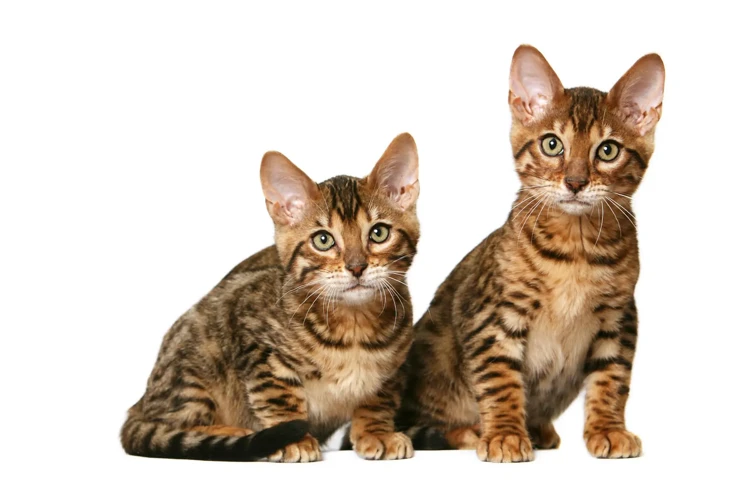
As a California Spangled cat owner, you want to do everything possible to ensure your feline companion enjoys optimal health and a long, happy life. One of the most crucial steps in achieving this goal is taking proactive measures to prevent genetic disorders from occurring. Fortunately, there are several practical steps you can take to minimize the risk of these conditions developing in your pet. In this section, we’ll explore these steps in more detail to help you protect your beloved California Spangled cat’s well-being. From finding a reputable breeder to conducting genetic testing, we’ll cover everything you need to know to keep your furry friend healthy and thriving.
Find a reputable breeder
One of the most important steps in avoiding genetic disorders in California Spangled cats is finding a reputable breeder. Not all breeders prioritize the health and well-being of their cats, so it’s important to do your research before committing to a breeder. Here are some tips for finding a reputable breeder:
- Research breeders online: Start by doing a search for California Spangled cat breeders in your area. Look for breeders who have positive reviews and a strong online presence, as this can indicate that they are reputable and committed to their cats’ health.
- Ask for recommendations: Reach out to fellow cat owners or local cat clubs for recommendations on reputable breeders. Getting a personal recommendation can be helpful in ensuring that the breeder you choose has a good reputation.
- Interview breeders: Once you’ve found a potential breeder, don’t be afraid to ask questions. A reputable breeder will be happy to answer any questions you have and provide you with information about their cats’ health, lineage, and any potential genetic disorders.
- Visit the breeder in person: Before committing to a breeder, it’s important to visit them in person and see the living conditions of their cats. Make sure the breeder keeps their cats in a clean and comfortable environment, and that the cats appear healthy and well-cared for.
- Avoid breeders who prioritize appearance over health: Some breeders prioritize physical appearance over health, which can lead to the spread of genetic disorders. Look for breeders who prioritize the health and well-being of their cats above all else.
- Ask for health guarantees: Reputable breeders will often offer health guarantees for their cats to ensure that they are free from genetic disorders. Make sure to ask for documentation of these guarantees before committing to a breeder.
By taking the time to find a reputable breeder, you can significantly reduce the risk of your California Spangled cat developing genetic disorders. Remember to do your research, ask questions, and prioritize the health and well-being of your future pet.
Ask for health certificates
One of the best ways to ensure that you are getting a healthy California Spangled cat is to ask the breeder for health certificates. Health certificates are important documents that provide detailed information about a cat’s health history. They are typically issued by a licensed veterinarian and can include information about vaccinations, diseases, surgeries, and other medical procedures.
When you are looking for a breeder, be sure to ask if they can provide you with a copy of the cat’s health certificate. If they cannot provide you with one, that could be a red flag that they may not be a reputable breeder. It is important to remember that responsible breeders will always be happy to share this information with you, as it helps to ensure that their cats are healthy and well-cared for.
Once you have received a copy of the health certificate, take the time to review it carefully. Look for any signs of illness or disease, such as an abnormal heart rate or abnormal blood tests. If you notice any concerns, be sure to ask the breeder for more information or for a referral to a specialist veterinarian who can provide more information.
To ensure that you are getting an accurate health certificate, it is also important to make sure that the certificate is up-to-date and reflects the current health status of the cat. It is not uncommon for health certificates to be out-of-date, so it is important to check that all of the information is accurate and that the certificate reflects recent veterinary visits.
Asking for a health certificate is an essential step when looking for a California Spangled cat. It provides crucial information about the cat’s health history and can help you make an informed decision about whether or not to purchase a particular cat. By taking the time to ask for this important document, you can help ensure that you bring home a happy and healthy feline companion.
| Why ask for a health certificate? | What to look for in a health certificate? | Why is an up-to-date health certificate important? |
|---|---|---|
| To ensure a healthy cat | Accuracy, illness, diseases, surgeries, medical procedures | To reflect the current health status of the cat |
| To ensure that the breeder is responsible | Vaccinations, heart rate, blood tests | To prevent obtaining an out-of-date or inaccurate certificate |
| To make an informed decision about purchasing a cat | Recent veterinary visits | To help prevent the purchase of an unhealthy cat |
Avoid inbreeding
Inbreeding, the practice of breeding closely related cats, can increase the risk of genetic disorders in California Spangled cats. When closely related cats are bred together, there is a higher likelihood of inherited diseases and other health problems. It is important to avoid inbreeding in order to maintain genetic diversity and minimize genetic disorders in the breed.
How to avoid inbreeding:
- Choose a reputable breeder who does not practice inbreeding. A good breeder should be aware of the risks and consequences of inbreeding and should have a plan for maintaining genetic diversity.
- Research the cat’s lineage to ensure that there is no evidence of inbreeding in the past. This can be done by requesting a pedigree from the breeder and studying the cat’s family tree.
- Consider introducing new genes into the breeding pool by outcrossing with other breeds that are genetically different from the California Spangled cat.
- Keep accurate and detailed records of each cat’s lineage and genetic history. This can help to identify any potential risks associated with inbreeding and can also be useful in preventing future cases of inbreeding.
Inbreeding can lead to a variety of genetic disorders in California Spangled cats, including HCM, PRA, and muscular dystrophy. While inbreeding may be tempting for breeders who want to keep desirable traits within the breed, it is important to prioritize the health and wellbeing of the cats above all else. By avoiding inbreeding, breeders can help to ensure that the California Spangled cat remains a healthy and thriving breed for years to come.
Genetic testing
Genetic testing is an important tool that can help you determine whether your California Spangled cat is at risk of developing certain genetic disorders. This can be especially useful if you are planning to breed your cat, as it can help you avoid passing on harmful genes to future generations.
There are several genetic tests that can be performed on California Spangled cats, including tests for hypertrophic cardiomyopathy (HCM), polydactylism, progressive retinal atrophy (PRA), and muscular dystrophy. These tests involve collecting a small blood or tissue sample from your cat and analyzing its DNA for specific genetic mutations.
Table:
| Genetic Disorder | Testing Method | Cost |
|---|---|---|
| Hypertrophic cardiomyopathy (HCM) | Echocardiogram or genetic DNA test | $200-$500 |
| Polydactylism | Physical examination and DNA test | $100-$200 |
| Progressive retinal atrophy (PRA) | Genetic DNA test | $100-$300 |
| Muscular dystrophy | Genetic DNA test | $150-$300 |
It is important to note that genetic testing can be expensive, with costs varying depending on the specific test being performed. However, the results can provide valuable information about your cat’s health and can help you make informed decisions about breeding or other aspects of their care.
If your California Spangled cat is found to have a genetic disorder, it is important to work closely with your veterinarian to develop a treatment plan that meets their specific needs. This may involve medication, surgery, or other interventions depending on the nature and severity of the disorder.
Ultimately, genetic testing is just one of several steps you can take to help prevent genetic disorders in California Spangled cats. By finding a reputable breeder, asking for health certifications, and avoiding inbreeding, you can help ensure that your cat is as healthy and happy as possible.
What to do if your California Spangled cat has a genetic disorder
As a cat owner, finding out that your beloved California Spangled cat has a genetic disorder can be a difficult and perplexing experience. It’s normal to feel overwhelmed and unsure about how to proceed. However, it’s important to understand that there are options and resources available to help you and your furry friend manage the situation. In this section, we’ll explore possible treatment options, lifestyle changes, and medical support that can assist you in navigating a genetic disorder diagnosis for your California Spangled cat. Let’s delve deeper into this topic and find out what steps you can take to give your furry companion the best possible care and support.
Treatment options
When it comes to treating genetic disorders in California Spangled cats, there are a variety of options available. The best course of action will depend on the specific disorder and its severity. Here are some possible treatment options:
| Treatment | Description |
|---|---|
| Medication | In some cases, medication can be prescribed to manage symptoms or slow the progression of a disorder. For example, cats with hypertrophic cardiomyopathy may be given medication to regulate their heart rate. |
| Dietary changes | For some disorders, changes in diet can be helpful. Cats with muscular dystrophy may benefit from a high-protein diet to support their muscle function. |
| Surgery | In certain cases, surgery may be an option to treat a genetic disorder. For example, cats with polydactylism may undergo a surgical procedure to remove extra toes that can cause discomfort or mobility issues. |
| Physical therapy | Cats with conditions that affect their mobility or coordination, such as muscular dystrophy, may benefit from regular physical therapy sessions to improve their muscle strength and range of motion. |
| Alternative therapies | In addition to traditional treatments, some cat owners may also consider alternative therapies such as acupuncture or massage to help manage symptoms or improve their cat’s quality of life. |
It’s important to note that for some genetic disorders, there may not be a cure available. However, even in these cases, there are often ways to manage symptoms and improve your cat’s quality of life.
If you suspect that your California Spangled cat has a genetic disorder, it’s important to consult with a veterinarian as soon as possible to determine the best course of action. Continuing with routine check-ups and monitoring your cat’s symptoms can also be helpful in managing their health.
Lifestyle changes
When a California Spangled cat is diagnosed with a genetic disorder, making certain lifestyle changes can help alleviate the symptoms and improve their quality of life. Here are some lifestyle changes to consider:
| Change | Explanation |
|---|---|
| Dietary modifications | Depending on the disorder, modifying the cat’s diet can be beneficial. For example, a cat with hypertrophic cardiomyopathy may need a low-sodium diet to ease the pressure on their heart. |
| Exercise management | Cats with muscular dystrophy may need to have their exercise limited or monitored to prevent further muscle deterioration. On the other hand, regular exercise may be helpful for cats with polydactylism, as it may improve their morale and balance. |
| Environmental modifications | Modifying the cat’s environment can be essential depending on the disorder. For example, a cat with progressive retinal atrophy may need a well-lit environment to compensate for their poor vision at night, while a cat with polydactylism may require toys and furniture with wider surfaces to accommodate their larger paws. |
| Stress reduction | Stress can affect a cat’s immune system and exacerbate certain genetic disorders. It is vital to provide a stress-free environment for cats with genetic disorders by reducing loud noises, introducing calming scents, and creating a comfortable and private space for them to retreat to. |
It’s important to note that while lifestyle changes can be beneficial, they shouldn’t be viewed as a substitute for medical treatment. If your California Spangled cat has a genetic disorder, it’s essential to work closely with your veterinarian to develop a comprehensive treatment plan that addresses both medical and lifestyle needs.
Medical support
Medical support is an essential aspect of managing genetic disorders in California Spangled cats. This support comes in the form of medications, supplements, and a regular visit to the vet. In severe cases, hospitalization may be required. Here are some of the medical support options available for your California Spangled cat:
| Option | Description |
|---|---|
| Medications | Medications can help manage symptoms and prevent the progression of genetic disorders. The type of medication prescribed will depend on the specific genetic disorder your cat has. |
| Supplements | Supplements can aid in managing symptoms and promoting overall health. For example, Omega-3 fatty acids can help reduce inflammation and support heart health for cats with Hypertrophic cardiomyopathy (HCM). |
| Vet visits | Regular visits to the vet are necessary to monitor the cat’s health, assess the effectiveness of treatments, and adjust the treatment plan if necessary. It is recommended to schedule regular check-ups at least once every six months if your cat has a genetic disorder. |
| Hospitalization | In severe cases, hospitalization may be required to manage the symptoms of genetic disorders. Hospitalization can help stabilize the cat’s condition and provide them with the necessary medical care. |
It is important to know that medical support alone may not be enough to manage genetic disorders. Proper care and lifestyle changes, such as a healthy diet and exercise routine, are necessary to help manage symptoms and improve overall health. If you suspect your California Spangled cat has a genetic disorder, it is crucial to consult with a veterinarian and develop a comprehensive treatment plan.
Conclusion
As we conclude, it’s important to remember that genetic disorders can affect any cat breed, including the California Spangled cat. However, being aware of these disorders and taking appropriate steps to avoid them can go a long way in ensuring the health and well-being of your feline friend. Let’s take a closer look at what we’ve covered in this article.
Summary
After exploring common genetic disorders in California Spangled cats and ways to avoid them, it’s important to summarize the key takeaways. Here are the main points to remember:
- California Spangled cats are a unique and stunning breed known for their spotted coats and wild look.
- Genetic disorders are unfortunately common in purebred cats, including California Spangled cats, due to the limited gene pool.
- Hypertrophic cardiomyopathy (HCM) is a serious heart condition that affects many cats, including California Spangled cats. It’s important to be aware of the signs and to have your cat regularly screened by a veterinarian.
- Polydactylism is an interesting genetic quirk that can result in extra toes on a cat’s paws. While it may not necessarily be harmful, it’s important to monitor your cat for any potential issues.
- Progressive retinal atrophy (PRA) is a degenerative eye disease that can lead to blindness. Regular check-ups with an ophthalmologist can help catch and manage PRA early on.
- Muscular dystrophy is a rare genetic disorder that affects the muscles and can lead to mobility issues in affected cats. Early diagnosis and management can help improve quality of life.
- To avoid genetic disorders, it’s important to find a reputable breeder who prioritizes the health and well-being of their cats. Ask for health certificates and avoid inbreeding to help reduce the risk of genetic disorders.
- Genetic testing can also help identify potential health issues early on and inform breeding decisions.
- If your California Spangled cat does have a genetic disorder, there are treatment options and lifestyle changes that can be made to help manage the condition and improve quality of life. Working closely with a veterinarian and other medical professionals can be crucial in these cases.
Being aware of genetic disorders and taking proactive steps to avoid them can help ensure that your California Spangled cat lives a long and healthy life.
Final thoughts
As a California Spangled cat owner, it is important to keep in mind that genetic disorders can occur in any breed. However, by taking the proper precautions, you can greatly reduce the likelihood of your feline friend developing a genetic disorder.
Always find a reputable breeder. A reputable breeder will prioritize the health of their kittens over making a profit. They will be transparent about the health of their breeding stock and provide you with necessary health certificates.
Ask for health certificates. Health certificates are documents that certify your kitten does not have any genetic disorders. They should be provided by the breeder or a veterinarian.
Avoid inbreeding. Inbreeding increases the likelihood of genetic disorders. Make sure your breeder does not practice inbreeding.
Consider genetic testing. Genetic testing can identify whether or not your kitten is a carrier of certain genetic disorders. This can help you make informed decisions about breeding and give you the opportunity to provide preemptive medical care.
If, despite your best efforts, your California Spangled cat does develop a genetic disorder, there are potential treatment options available. These may include medications, surgery, or lifestyle changes. Be sure to consult with your veterinarian to develop the most effective treatment plan for your cat.
In any case, remember to be patient and understanding with your cat. They may require extra care and attention, but with love and support, they can still lead happy, fulfilling lives.
Frequently Asked Questions
1. What is the average lifespan of a California Spangled cat?
The average lifespan of a California Spangled cat is around 11-14 years.
2. Are California Spangled cats hypoallergenic?
No, California Spangled cats are not hypoallergenic. Like other cat breeds, they produce dander and saliva, which can trigger allergies in some people.
3. Do California Spangled cats require a lot of grooming?
No, California Spangled cats have short, shiny coats that require minimal grooming. Occasional brushing and nail trimming is usually sufficient.
4. Can California Spangled cats be trained?
Yes, California Spangled cats are intelligent and trainable. They can learn many tricks and commands with positive reinforcement training.
5. Are California Spangled cats good with children?
Yes, California Spangled cats are generally good with children. However, as with any cat, it’s important to supervise interactions between children and cats to ensure everyone’s safety.
6. Do California Spangled cats like to play?
Yes, California Spangled cats are active and playful. They enjoy playing with toys and interacting with their owners.
7. Are California Spangled cats prone to obesity?
Like many cat breeds, California Spangled cats can be prone to obesity if they are overfed and don’t get enough exercise.
8. Do California Spangled cats have any unique personality traits?
Yes, California Spangled cats are known for their outgoing and affectionate personalities. They enjoy being around people and have a strong bond with their owners.
9. Can California Spangled cats live in apartments?
Yes, California Spangled cats can adapt well to apartment living as long as they have plenty of toys, scratching posts, and opportunities to play and exercise.
10. How much does a California Spangled cat typically cost?
The cost of a California Spangled cat can vary depending on the breeder and the cat’s pedigree. Expect to pay anywhere from $1,000 to $3,000 for a California Spangled kitten.

